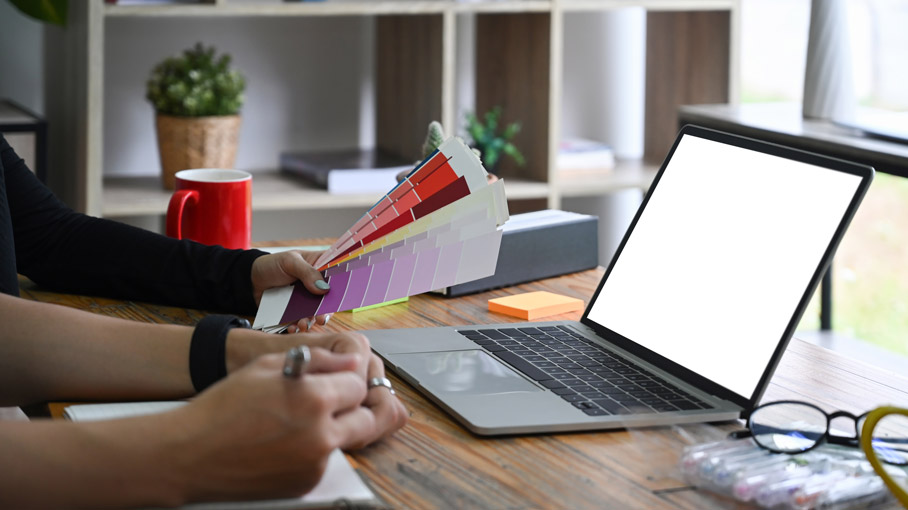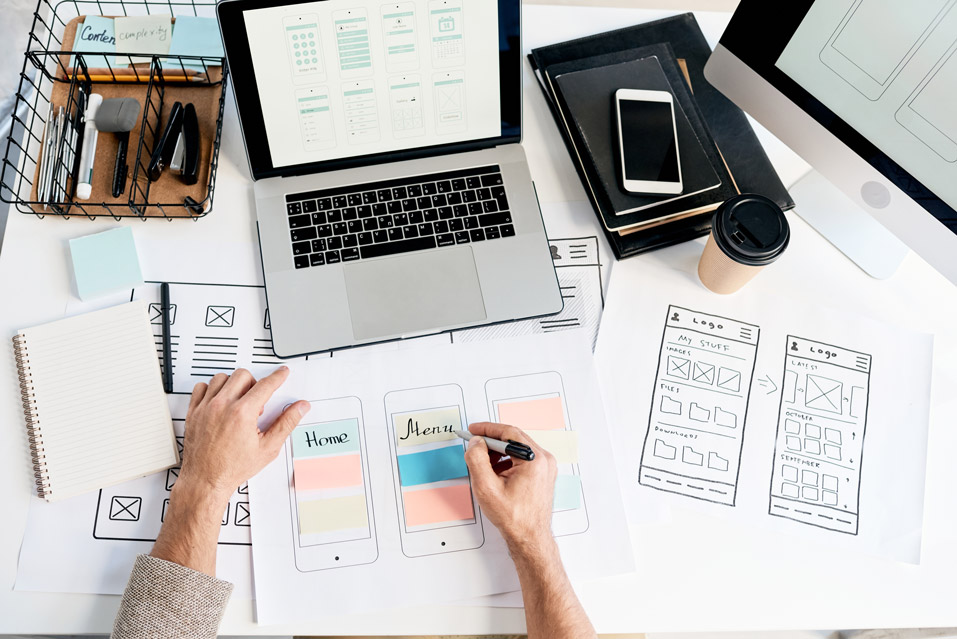
UI/UX design is a hot field in 2024, blending creativity with tech skills to make using websites, apps, and other digital products a better experience for everyone. When we talk about UI (User Interface) design, we’re focusing on making things look good and easy to use.
Things like websites, apps, and other products need to be both pretty and practical. UX (User Experience) design, on the other hand, dives into making sure everything works smoothly and makes sense for the user, focusing on the technical side of things.
With more businesses popping up left and right, big and small, the need for top-notch UI/UX design services has skyrocketed. This boom has also led to a high demand for skilled UI/UX designers. So, if the world of UI/UX design grabs your interest and you’re just starting out, you’ve picked a great time to dive in.
This article is here to guide beginners through the ins and outs of UI/UX, pointing you toward the best places to learn and the top courses to get you started.
Whether you’re interested in providing ui/ux design services, mastering ux ui design, or stepping into the freelance web designer arena, there’s a lot of opportunity out there. The growth in this field doesn’t seem to be slowing down, meaning the need for fresh, talented designers is only going to grow.
For beginners, this means a world of opportunity to not only learn and grow but also to make a significant impact on how businesses connect with their users.
So, where do you start? Look for institutes that offer comprehensive UI/UX design programs, specifically designed with beginners in mind. These courses should cover the basics and gradually dive into more complex concepts, ensuring you build a solid foundation.
Easy Step-by-Step Guide to UI/UX Design for Beginners
Exploring UI (User Interface) Design
User Interface (UI) design is a lot like giving your room a makeover but for websites and apps instead. It’s all about making screens and features not just look good but also work smoothly. Think of it as if you had a robot buddy. Your job is to make its screen and buttons both look cool and be super easy to use. That’s what UI designers are great at!
These designers pick out eye-catching colors, shapes, and pictures for buttons and screens, kind of like how you’d choose the right color for your walls or the perfect sofa for your living room. The goal is to make everything not just look nice but also simple to understand. You wouldn’t want your robot friend to get lost using its own features, right?
Take your favorite game on your phone – those inviting buttons that kick off the game or let you buy Shopify within the app are made to grab your attention and make playing the game even better. That’s UI design for you!
Even gadgets that listen and talk back to you, like Siri, show how important UI design is. They reply to what you say with friendly voices and clear info.
At its core, UI design is about making our digital spaces look amazing and feel easy to use, similar to how you’d want your room to be both stylish and comfy. It’s about creating a perfect environment for your robot or app. And if you’re thinking, “I need a web designer near me to do this,” you’re on the right track.
Finding a local web designer or seeking out top-notch UI UX design services can help bring your digital projects to life, making them as welcoming and functional as your favorite spot at home.
Getting to Know UX (User Experience) Design:

UX design is like being the captain of a ship on a treasure hunt but for websites and apps. It’s about making the journey fun, easy, and rewarding for everyone involved. As the captain, your job is to guide your crew (the users) through an adventure that’s not just exciting but also simple to follow.
Think of UX designers as the creators of treasure maps. They decide on the look of the map with cool pictures and colors (that’s the brand look), plot out the path to follow (that’s the layout), and make sure the map is easy for the crew to use (that’s making it user-friendly). The ultimate goal? Finding the treasure (which means making sure the website or app does what it’s supposed to do).
Take your favorite game on your phone, for example. The way it looks and feels is unique (that’s the branding). Figuring out how to play it is straightforward (that’s the layout and design), it’s enjoyable so you keep coming back (that’s user-friendliness), and you get a kick out of playing (that’s the purpose it serves).
Or consider an online food ordering site. It has a look you can recognize anywhere (branding again). Scrolling through the menu and placing your order is super easy (that’s the design working for you), and your food arrives just like you wanted (that’s the site doing its job).
In short, UX design is about creating awesome online experiences where everything looks cool, works smoothly, and keeps people coming back for more. Whether it’s for UX design services, UX ui design, or even e-commerce website designers, it’s all about making the digital treasure hunt as enjoyable as possible. It’s like being the brains behind the most epic digital treasure hunt!
Key UI (User Interface) Design Principles for Beginners
Start your adventure into UI (User Interface) Design with these fundamental principles. Here’s a handy guide, perfect for students eager to begin their journey in this exciting career path.
Making it Work for Everyone: Accessibility
Make sure everyone can use your design, including people with disabilities. Stick to guidelines that help make things accessible for all.
Guiding the Eye: Visual Hierarchy
Arrange items on your screen so it’s clear what’s most important. This helps users know where to focus first.
Easy to Pick Up: Learnability
Design so that even first-time users find it simple to get the hang of your interface.
Stopping Mistakes Before They Happen: Error Prevention
Think ahead about possible mistakes users could make and try to stop them before they happen. If errors do occur, make it easy to fix them.
Making Things Fast: Efficiency
Make your design so users can do what they need quickly and easily. Smooth paths are key.
Talking Back: Feedback
When users do something, tell them what happened or if there’s a problem. Quick responses make things less confusing.
Keeping it Together: Consistency
Use the same colors, fonts, and buttons throughout your design to keep things feeling familiar and connected.
Fits All Screens: Mobile Responsiveness
Design with all device sizes in mind, so your interface looks good and works well, no matter the screen.
Looking Good: Aesthetics
Make sure your design is not just functional but also nice to look at. Good looks can improve the experience.
Simple and Clear: Clarity
Keep your design straightforward and easy to understand. Avoid clutter to help users navigate easily.
Diving into UI design means constant learning and practicing, especially as technology and trends change. Keep exploring and experimenting, and you’ll grow your skills in creating user-friendly, beautiful interfaces.
Essential UX (User Experience) Design Principles for Beginners

Dive into the must-know basics of UX (User Experience) Design, a guide full of tips for those wanting to start a career in this exciting area.
Accessibility
Make sure everyone can use your product, even people with disabilities. Follow rules that help make things easier for everyone.
Easy to Learn: Learnability
Create your product so that new users can quickly understand how to use it, making their first experience smooth.
Keeping it Simple: Usability
Your product should be easy and straightforward. Users should find what they need without any hassle.
Feedback is Key: Feedback and Response
Let users know what’s happening. When they do something, show a response so they’re not left wondering.
Testing with Real People: User Testing
Check your design with real users often. Their feedback can show you what needs fixing or improving.
Keeping Things Familiar: Consistency
Use a consistent design across your product. It makes things feel familiar and easier to use.
Organizing Information: Information Architecture
Arrange your content in a clear way. Good organization makes information easier to find and understand.
Ready for Any Screen: Mobile Responsiveness
With so many using mobile devices, make sure your design looks good and works well on any screen size.
Less is More: Minimalism
A simple design is best. Remove anything that’s not needed to make your product easier to use.
Think About Your Users: User-Centered Design
Always put your users first. Understand what they need and want, and design with those needs in mind.
Following these principles will help you create better, more user-friendly products. Whether you’re just starting out or looking to improve your skills, these basics are your foundation in the world of UX design.
Dive Into Top Tools for UI and UX Design
Jump into the world of UI (User Interface) and UX (User Experience) Design with these must-have tools. These are just a few picks from the vast toolbox available for designers:
Top Tools Every UI Designer Should Know
Embark on your UI (User Interface) Design journey with these essential tools. Perfect for both solo and team projects, these tools are the bread and butter for anyone in the UI design field:
UI Design Tools: Crafting Stunning Interfaces

Figma: Think of Figma like a digital art studio where everyone can paint on the same canvas at the same time, no matter where they are. It’s great for working together with your team, sharing ideas, and making changes on the fly.
Sketch: This tool is like the Swiss Army knife for UI designers. Sketch is famous for making design work smooth and efficient, thanks to its cool plugins and easy ways to share your work with others.
Adobe XD: Imagine a tool that’s super easy to use and helps you make your design ideas come to life. Adobe XD does just that, letting you create and test your designs all in one place. Plus, it plays nicely with other Adobe apps, making it a handy tool for designers.
InVision: Picture a magic mirror that brings your designs to life. InVision lets you turn your static designs into clickable prototypes that look and feel like the real thing. It’s a great way to see how your designs work in action and get feedback from users.
These tools are key for anyone looking to dive into UI design. They help you create beautiful, functional designs and test them to see how they’ll work in the real world. Getting familiar with these tools can give you a head start in the world of UI design.
UX Design Tools: Making Sense of User Needs
Hotjar: Imagine having a magical lens to see exactly how people use your website or app. Hotjar shows you videos of users’ actions and gives you surveys to understand their thoughts, helping you make things better for them.
UserZoom: This is like having a Swiss Army knife for UX research. Whether you need to test your designs, ask users questions, or dive deep into studies, UserZoom has got you covered with all the tools you need.
Optimal Workshop: Think of this as your organizing wizard for designing how information is laid out on your site or app. With cool tools like Treejack for sorting info and OptimalSort for figuring out categories, it helps you make your projects easy to navigate.
Miro: Picture a huge whiteboard that you and your team can draw on from anywhere in the world. Miro is perfect for brainstorming sessions, mapping out user journeys, and planning together in real-time.
These tools each play a special role in refining your UX design process, from understanding how users interact with your designs to collaborating on creative solutions. Getting to know these tools can give you a solid start in mastering UI/UX design.
Conclusion:
As you set off on your adventure to become a UI/UX designer, remember to always think about the people you’re designing for. Try to get into their shoes to understand what they need and what obstacles they might face. Keep working on your skills, and put together a portfolio that shows how you’ve solved various challenges.
It’s also a great idea to connect with seasoned designers. They can offer you pearls of wisdom and spark your imagination. Stay curious, keep up with the latest design trends, and never stop learning.
UI/UX design is all about teamwork and coming up with digital solutions that make life better for people. Keep your passion for design burning bright. This field is always changing, which means there are always new things to learn and exciting challenges to tackle.
Your goal is to make technology more friendly and fun for everyone—a noble quest, indeed. Keep that excitement going, and you’re sure to do well in this vibrant and changing world.
When you’re building websites or working on digital projects, think about how website design & development plays a crucial role in creating enjoyable user experiences. If you’re offering UX design services, always aim to understand and meet your users’ needs.
And if you’re part of a UX UI design agency, collaboration and creativity should be at the heart of what you do. This approach will not only lead to successful projects but also ensure a rewarding career in UI/UX design.
